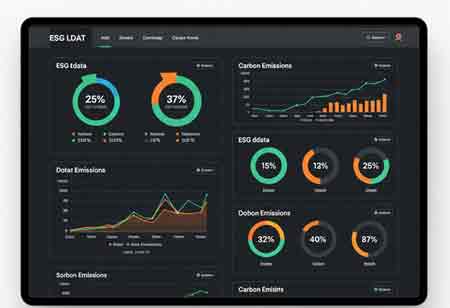CLOSE
Specials
I agree We use cookies on this website to enhance your user experience. By clicking any link on this page you are giving your consent for us to set cookies. More info
Be first to read the latest tech news, Industry Leader's Insights, and CIO interviews of medium and large enterprises exclusively from Energy Tech Review
Thank you for Subscribing
The Role of Integrated Platforms in Carbon Footprint Management in Europe
The European oil and gas sector is facing increased scrutiny of its ESG performance, necessitating the development of integrated platforms for effective carbon management amid regulatory pressures and investor demands.

By
Energy Tech Review | Wednesday, July 23, 2025
Stay ahead of the industry with exclusive feature stories on the top companies, expert insights and the latest news delivered straight to your inbox. Subscribe today.
Fremont, CA: The European oil and gas sector is navigating an era of unprecedented scrutiny, driven by accelerating climate goals, stringent regulatory frameworks such as the Corporate Sustainability Reporting Directive (CSRD), and growing investor demands for transparency. In this complex landscape, integrated platforms are emerging as indispensable tools, overhauling how companies manage, report, and act upon their Environmental, Social, and Governance (ESG) performance, particularly their carbon footprint.
The Evolving Landscape: Pressures and Imperatives
Historically challenged by its carbon intensity and complex value chains, the oil and gas industry now faces a dramatically shifted ESG reporting landscape. European regulations, spearheaded by the CSRD and its accompanying European Sustainability Reporting Standards (ESRS), are making comprehensive and auditable ESG disclosures mandatory for a growing number of large companies. These regulations require detailed data on environmental factors (including Scope 1, 2, and 3 emissions), social aspects (such as labour practices and human rights), and governance structures.
Beyond compliance, investors are increasingly embedding ESG criteria into their decision-making, favouring companies that demonstrate strong sustainability performance and robust disclosure. This translates into a competitive advantage, impacting access to capital, market valuation, and even executive compensation. The pressure to achieve carbon neutrality by 2050, aligned with the Paris Agreement and the EU's climate laws, further accentuates the need for precise carbon accounting and effective emissions reduction strategies.
Key Ways Integrated Platforms Drive Effectiveness
A key feature of these integrated platforms is automated carbon accounting, which leverages globally recognised standards such as the GHG Protocol (Scopes 1, 2, and 3) and ISO 14064. By automating greenhouse gas calculations, companies significantly reduce manual effort, minimise errors, and conduct more frequent, accurate carbon footprint assessments. Many solutions also provide scenario modelling to support reduction planning.
Integrated platforms are designed to support compliance and regulatory alignment, particularly for European oil and gas companies navigating frameworks like the CSRD, SFDR, and the EU Taxonomy. With pre-built templates and reporting functionalities aligned with ESRS and other relevant standards—often supporting machine-readable formats, such as XBRL—they streamline complex reporting processes and ensure regulatory adherence.
Enhanced data accuracy and auditability are achieved through automated data collection and built‑in validation checks, resulting in reliable ESG data and clear audit trails. This enables companies to confidently demonstrate the integrity of their disclosures to third-party auditors, a key requirement under the CSRD.
Integrated dashboards and analytics provide real-time visibility into ESG key performance indicators (KPIs), allowing organisations to track progress, identify areas for improvement, and make informed, data-driven decisions. These platforms also enhance stakeholder engagement by providing comprehensive and easily accessible repositories of ESG data. Interactive dashboards and portals promote transparency, facilitate collaboration, and strengthen trust among investors, regulators, customers, and the wider public.
With the outlook for integrated ESG platforms, regulatory pressures mounting, and investor expectations rapidly evolving, the adoption of advanced technological solutions is no longer optional; it is essential. Organisations that proactively invest in and effectively utilise these platforms will be well-positioned to meet increasingly complex reporting requirements with confidence, demonstrate a genuine commitment to sustainability, attract sustainable financing, and strengthen their market reputation. These platforms also enable companies to identify and mitigate risks more effectively, drive innovation, and accelerate their transition toward a lower carbon future.

Copyright © 2025 Energy Tech Review. All rights reserved






